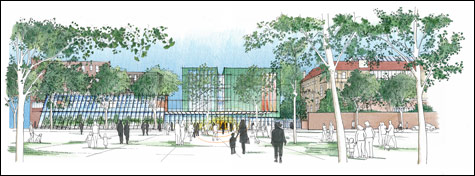
INTO THE OLD THROUGH THE NEW From Evans Way, you’ll enter Piano’s addition — center, with its exhibition room and concert hall and shop and café — before turning right, passing through a 50-foot walkway, and emerging into Isabella Stewart Gardner’s museum from the rear. |
On January 1, 1903, Isabella Stewart Gardner invited 300 guests to a private concert by members of the Boston Symphony Orchestra to celebrate the opening of her new museum on the Fenway. After performances of Bach, Mozart, and Schumann, the mirrored doors of the first-floor concert room rolled open to reveal an extraordinary vision: a four-story-tall courtyard in the center of the building filled with flowers and lit by Japanese paper lanterns.
Guests wandered off into candlelit galleries, each lavishly furnished with a mix of old master paintings (Botticelli, Titian, Vermeer, Rembrandt), contemporary works (John Singer Sargent), antique furniture, architectural details, and tapestries. When they sat down to supper in a second-floor gallery full of 17th-century Dutch masterpieces, many must have shared the thoughts of philosopher William James. "The æsthetic perfection of all things," he wrote, "seemed to have a peculiar effect on the company, making them quiet and docile and self-forgetful and kind. Quite in the line of a Gospel miracle!"
In our era, when museums increasingly feel like the group-think of corporate teams, Gardner's ravishing, theatrical, treasure-packed, idiosyncratic one-woman gesamtkunstwerk is ever more a miracle. On January 21, when the Gardner Museum unveiled Italian architect Renzo Piano's designs for an addition, the question was whether his sleek, boxy, copper-clad, glass-and-steel structure, at a cost of $114 million, would sap and distract from Gardner's original Venetian Renaissance-inspired palazzo.
During Gardner's day, some 2000 persons visited annually. Today attendance is 200,000 per year. "What started coming out was the incredible overuse of the building and how it wasn't sustainable," Gardner director Anne Hawley tells me. The 70,000-square-foot addition (the palazzo is 60,000) is built to house public and private services that have ballooned since Gardner's death in 1924.
Due to open in 2012, it will sit behind the palazzo, facing onto Evans Way — and its entrance will be the museum's. The bottom floor will be all glass, exposing the inside to the surrounding gardens and street, and vice versa. "Light is one of the most important materials of architecture," Piano said during a talk last March at Harvard University, where he has designed an ongoing renovation and expansion of the Harvard Art Museum. "Transparency is still a very important quality of urban life. . . . Urbanity comes because the buildings talk to the street."
To your left, as you enter, will be the museum shop; to your right, a visitor-orientation room that will look out to the palazzo, and behind that the new café. A glass corridor will connect the new building to the old, 50 feet away, where Gardner's astonishing displays of art will remain untouched, for the most part, and some spaces that have been freed up by the addition will become new galleries. New greenhouses will be created to the left of the addition.